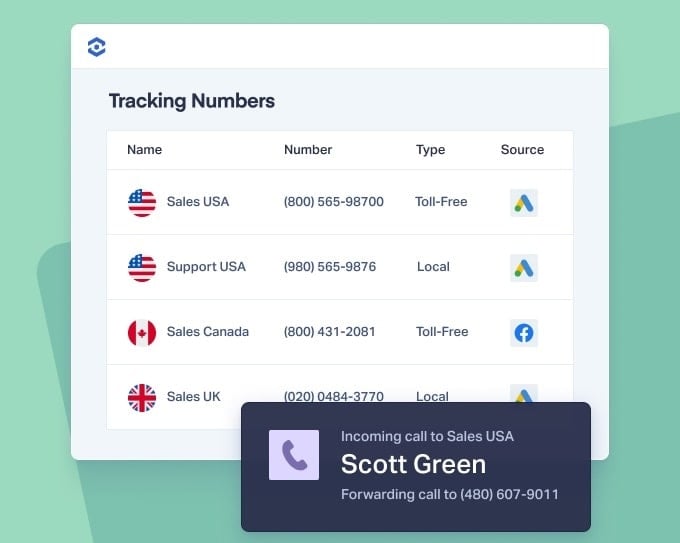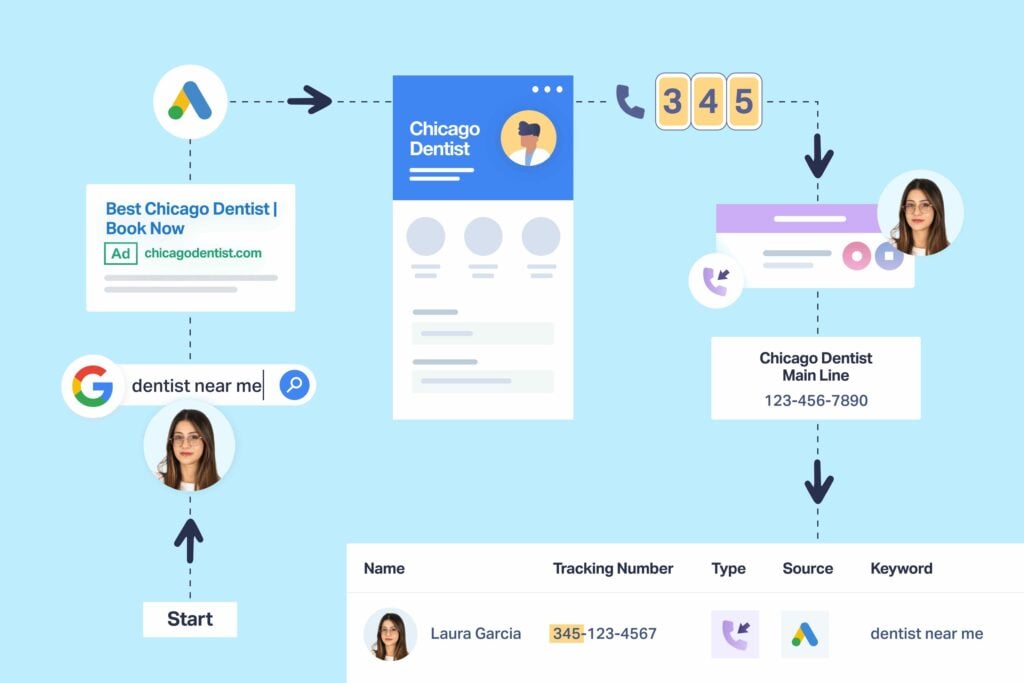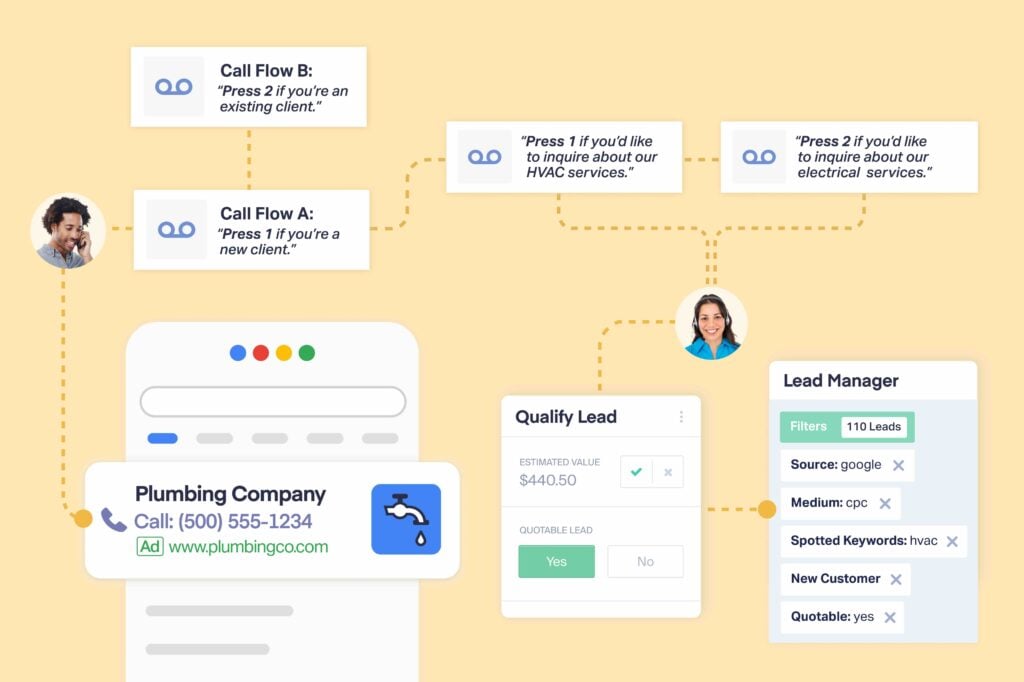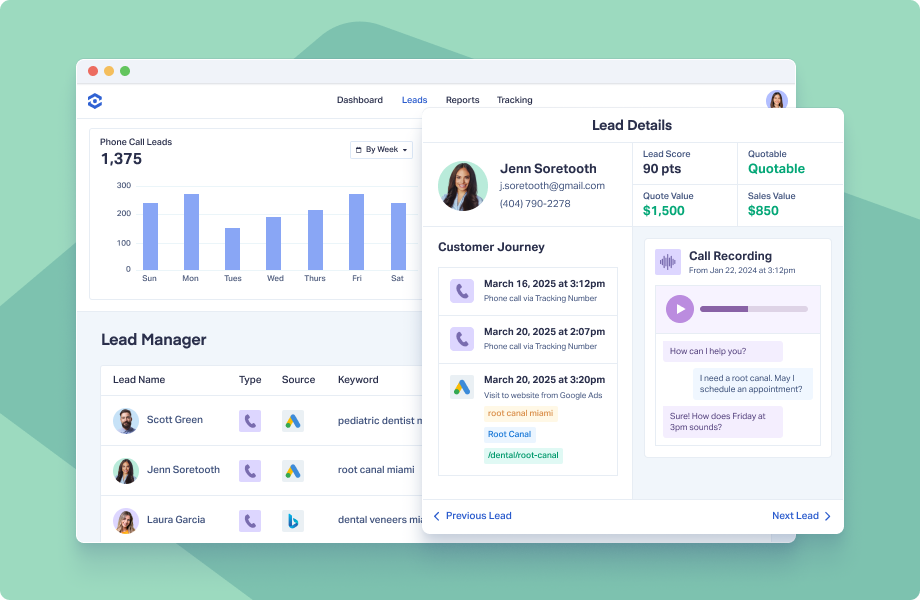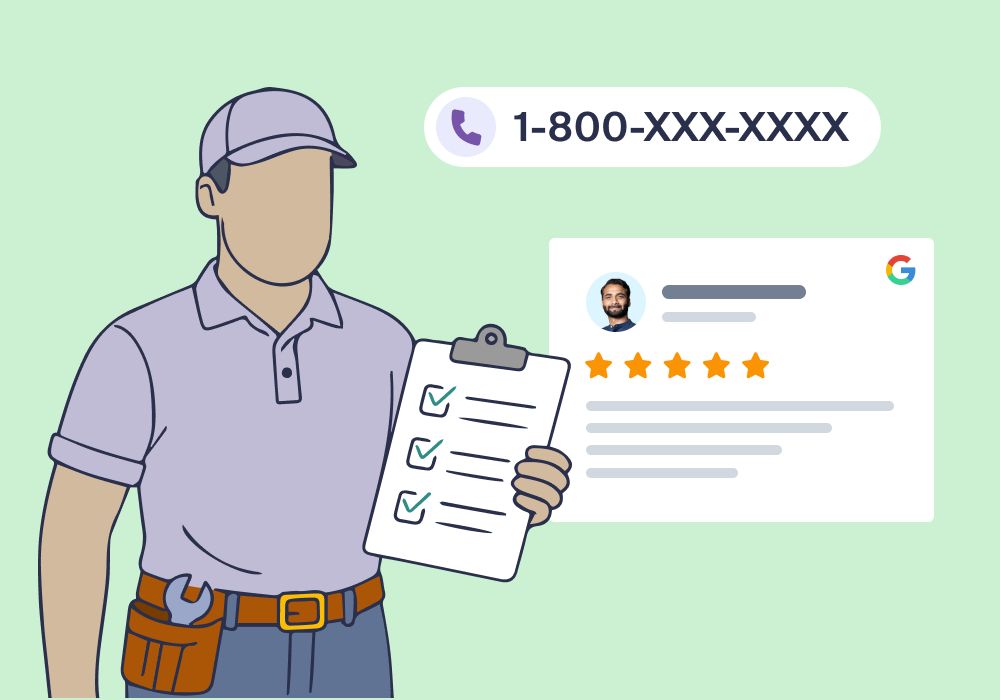
More than 44 million toll-free numbers are active in the United States today. And it isn’t because of the cost savings these numbers used to provide. Instead, it’s about trust—trust that your company is established, professional, and ready to solve your customers’ problems even if you’re a service-based business.
In this article, you’ll learn exactly how to get a 1-800 number and why you should consider it. We’ll break down the step-by-step process—choosing a provider, reserving a memorable number, configuring call routing, and integrating tracking—so you can launch your own toll-free line with minimal hassle.
Just as important, we’ll show you how pairing that number with call-tracking platforms like WhatConverts quietly turns every ring into a data point, making your 1-800 investment a measurable growth lever rather than a vanity expense.
Bottom line: by the end of this guide you’ll have a clear, actionable roadmap for securing a 1-800 number that strengthens trust, invites more inquiries, and feeds the analytics you rely on to prove ROI. You’ll also learn how to easily get both 1-800 and local numbers using WhatConverts.
Book a demo or start your 14-day free trial of WhatConverts now!
Why a 1-800 Number Matters for Service-Based Businesses
Boosts Professional Perception
More than 74% of Fortune 500 companies still list a toll-free number—and over half of them keep the “true” 800 prefix—because the format instantly signals scale, stability, and customer focus. Even a small contractor can borrow that enterprise aura simply by advertising a 1-800 (or 888, 844, 866, etc.) line.
Supports National (or Global) Reach
Because toll-free numbers are non-geographic, they make a local shop look national—no extra offices required. One industry review notes that an 800 number helps brands “appear more accessible, reliable, and stable” to out-of-state customers.
If you’re a service-based business looking to expand your service area, a 1-800 number might be a perfect fit.
Powers Memorability and Marketing
In controlled tests, 72% of viewers recalled a vanity 800 number after a 30-second ad, compared with just 5% who remembered a random numeric line. Ads that swapped in a vanity number delivered ≈33% more responses than those with a generic phone number.
With a vanity number, your phone number itself becomes built-in marketing for your business.
Looking for a vanity number? Get in touch with support for a quote.
Removes Caller-Cost Barriers
When the call is free, prospects stay on the line longer. In fact, businesses that switch to toll-free report about 30% longer conversations and stronger engagement according to the American Teleservices Association (ATA).
And though smartphone plans have made calling less expensive, some prospects will still appreciate the savings.
Enhances Lead Tracking and ROI Measurement
Assigning unique toll-free numbers to each campaign lets you trace every ring back to the exact ad, keyword, or postcard that sparked it. Platforms like WhatConverts call-tracking capture the marketing source, record the call, and tie revenue back to phone leads—turning your 1-800 investment into measurable ROI.
Key takeaway: a well-chosen 1-800 number isn’t just a convenience—it’s a credibility badge, a marketing hook, and a data pipeline you can optimize for profit. (We’ll show you how to get 1-800 number set up in the next section.)
Step-by-Step: How to Get a 1-800 Number
Step 1 – Choose Your Provider
- Decide on a platform. Most service businesses opt for cloud VoIP providers such as RingCentral, Grasshopper, 800.com, or Nextiva because you can buy and manage toll-free numbers entirely online. Traditional carriers still work, but features and portability are limited. WhatConverts also offers toll-free 1-800 numbers right in the platform.
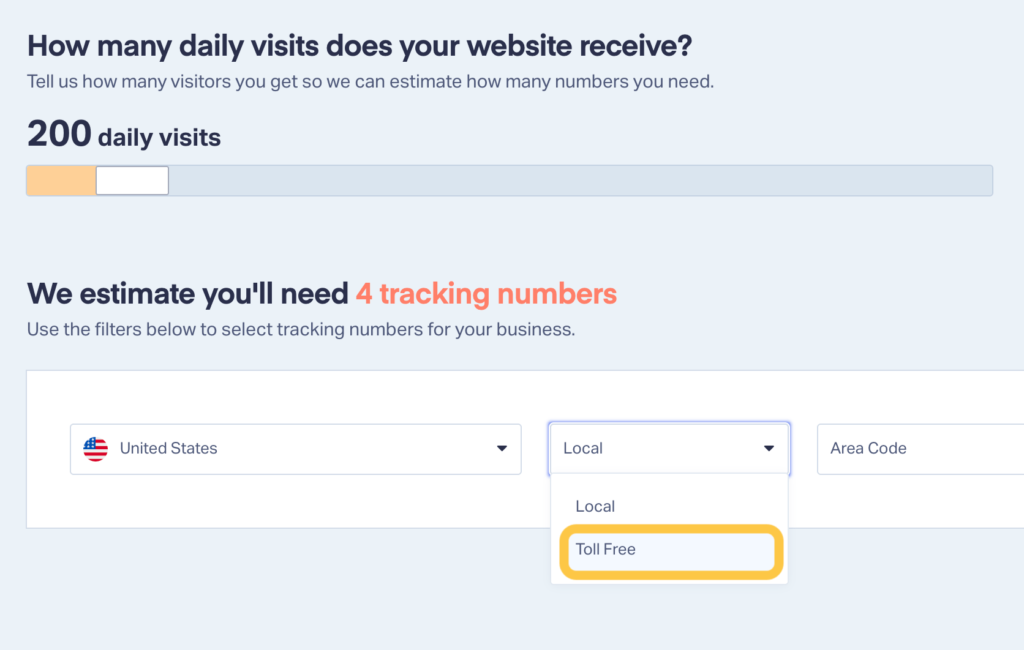
- Compare costs and plans. Expect to pay ≈ $10–$15 per month for a basic toll-free line, plus $0.06–$0.30 per minute of usage. Some providers bundle the first 1-800 number at no extra charge. Note: Toll-free numbers start at $3 and $0.06 per minute with WhatConverts. See our pricing here.
- Check for must-have features. Look for:
- built-in call analytics or easy integrations
- mobile/desktop apps for remote management
- straightforward porting rules (so you can move your number later)
- Read recent reviews on sites like G2 or Capterra to confirm uptime, support responsiveness, and porting success stories.
Step 2 – Select Your Number Type
| Choice | What it means | When to pick it |
| True 800 prefix | Classic 800 code that 50.9 % of Fortune 500 companies still use | You want the most recognizable toll-free signal and one is available |
| Newer prefixes (833, 844, 855, 866, 877, 888) | Functionally identical to 800 | Your preferred 800 variant is taken, or cost/availability is better on newer codes |
| Vanity number | Spells a word (e.g. 1-800-PLUMBER) or uses a memorable pattern | Branding and ad recall are top priorities—vanity lines boost response rates by ~33 % in direct-response tests. Note: Contact support for a vanity number quote. |
| Straight numeric | Random digits, often cheaper and instantly available | Speed matters more than memorability—upgrade to vanity later if desired |
Step 3 – Pick Your Features
Most VoIP plans let you add or drop features à la carte. Focus on the ones that improve customer experience and data quality:
| Feature | Why it matters |
| Call forwarding / IVR / simultaneous ring | Never miss a lead—route 1-800 calls to your mobile, office, or the whole crew at once. |
| Custom greetings | Sound established and guide callers (“Press 1 for estimates, 2 for support”). |
| Call-to-email | Respond faster when you’re in the field; no digging through phone menus. |
| SMS-enabled toll-free | Let prospects text for quotes or appointment confirmations on the same number. |
| Call recording & analytics | Monitor quality, coach staff, and verify what turns a call into revenue. |
Implementation tip: Start lean—turn on forwarding, voicemail, and basic analytics first. You can layer IVR menus or SMS later without switching numbers.
Step 4 – Set Up and Configure
- Map your call flow. In your provider’s portal, define business hours, after-hours routing, and fallback destinations (e.g. an answering service).
- Test every scenario. Dial your new number from different phones to verify greeting playback, forwarding delays, and voicemail capture.
- Use offline and online numbers. For offline campaigns (billboards, postcards), use a single number for each campaign. For online marketing (Google Ads, a number on your website), use dynamic number insertion (DNI) so you can track every lead individually.
- Train your team. Make sure staff recognize the 1-800 caller-ID tag and know the script for answering.
Step 5 – Integrate With WhatConverts (or Your Analytics Stack)
- Add the number to WhatConverts. You can either purchase the toll-free line inside the platform or port the one you just secured.
- Enable Dynamic Number Insertion. Paste the WhatConverts script on your website so visitors see a unique toll-free number tied to their traffic source.
- Tie calls to revenue. Mark qualified calls and closed deals inside WhatConverts; the platform attributes revenue back to the campaign, keyword, or ad that triggered the dial.
- Automate reporting. Build dashboards that blend phone leads with form fills and chat conversions to show a full-funnel picture.
Outcome: Your 1-800 number goes from a vanity expense to a trackable, optimizable growth lever—and you’ll know exactly which marketing dollars made the phone ring.
Cost & ROI Considerations
Even with today’s low-cost VoIP options, a toll-free line is still an investment. The upside is that—when paired with call-tracking—it often pays for itself within the first few closed jobs. Below is a realistic snapshot of what you’ll spend (and save) as a service business.
| Expense | Typical Range | WhatConverts | What to Watch For |
| Number rental | $17–$25 per month for one toll-free line (e.g., GoDaddy Conversations starts at $16.99/mo; most full-featured VoIP plans sit around $20/mo | Starting at $3 per line | Confirm that the first 1-800 number is included in your base seat price; some providers treat it as an add-on. |
| Usage charges | $0.019–$0.03 per inbound minute on pay-as-you-go plans (DIDforSale’s starter tier is $0.019/min; many bundle “unlimited” minutes into higher-tier plans) | Starting at $0.06 per minute | Ask how “unlimited” is defined—some carriers throttle after a fair-use threshold. |
| Vanity-number premium | One-time $30–$100 for common words; four-figure prices for high-competition phrases | Depends on the number; Contact support for a quote | A memorable word usually costs less than a single lead acquisition on Google Ads—worth it if you run broadcast or print. |
| Port-out / cancellation fees | ~$0 with reputable VoIP providers | $0 | Verify there’s no penalty to move the number later; FCC rules guarantee portability. |
Hidden Fees to Avoid
- Setup charges (rare in 2025—skip vendors that still levy them).
- Per-device licensing on top of per-user pricing.
- SMS surcharges if you plan to text-enable the toll-free line.
Will It Pay for Itself? A Quick Breakeven Check
- Total monthly cost
- Number rental ($20) + estimated minutes (300 min × $0.02 = $6) = $26
- Leads required to break even
- If your average job nets $250 profit and 1 in 4 calls converts, you need just ½ of one extra booked job per month to cover the line.
- Why that’s plausible
- For a contractor averaging 40 inbound calls, even a conservative 10% lift → 4 extra calls → 1 additional job—comfortably eclipsing the ~$26 outlay.
ROI Accelerators
| Tactic | Impact |
| Dynamic Number Insertion (DNI) via WhatConverts | Shows each visitor a unique 1-800 line tied to their traffic source, letting you funnel ad spend toward channels that actually ring. |
| Call scoring and revenue tagging | When you mark qualified calls and closed deals, WhatConverts pushes ROI data straight to your dashboard—fuel for smarter bidding rules. |
| Rotating vanity lines in split tests | Test 1-800-DRAINS against 1-800-PLUMBER for lawn-sign campaigns; keep the higher-converting phrase, release the rest. |
| SMS follow-ups on missed calls | An automated “Sorry we missed you—text us your question” recaptures prospects who hang up during peak times, squeezing extra revenue from the same number. |
Key takeaway: A well-configured 1-800 number typically adds < $1 a day to your overhead yet can drive double-digit lifts in call volume and customer trust. When every ring is tracked back to revenue, the real cost isn’t the monthly fee—it’s the opportunity lost by not offering a toll-free path to your business.
Alternatives: When a Local Number (or Hybrid Setup) Makes More Sense
A 1-800 line isn’t always the single best answer. In several situations, keeping—or even prioritising—a local area-code number can outperform a toll-free option. Consider these use-cases before you decide:
| Scenario | Why a Local Number Wins | Practical Tip |
| You serve a tight geographic community | A familiar area code signals “we’re your neighbours,” boosting instant trust among hyper-local buyers such as neighbourhood boutiques, family-run restaurants, or city-only contractors. | Display the local number prominently on street-level ads, directories, and Google Business Profile; list the 1-800 line only where you target a wider radius. |
| Outbound calling and follow-ups | Prospects increasingly screen unknown or toll-free Caller-ID—local numbers see higher pickup rates and fewer voicemail dumps. | Use your VoIP portal to show a local caller-ID on outbound dials while still receiving inbound leads on the 800 line. |
| Cost-sensitive micro-businesses / start-ups | Local numbers are typically a few dollars cheaper per month and avoid per-minute toll-free charges—ideal if call volume is still modest. | Start local, monitor call growth; add a toll-free line once expansion or multi-state marketing kicks in. |
| Local SEO and “near-me” searches | Search engines weigh NAP (Name-Address-Phone) consistency; an area-code number reinforces geographic relevance in local pack results. | Make the local number the default in local-directory citations while keeping the 1-800 on national ads. |
| Market-entry into a new city | Launching with that city’s area code helps you “blend in” and gain trust before prospects know your brand. | Pair the new local line with campaign-specific tracking in WhatConverts so you can retire it once brand recognition grows. |
The Hybrid Sweet Spot
Most mature service businesses run both:
- Local line for hometown familiarity—featured on neighbourhood flyers, vehicle wraps, and outbound calls.
- 1-800 line for scale and marketing lift—plastered on the website, national PPC, and any channel with out-of-area reach.
Modern VoIP platforms make this seamless: route both numbers into the same ring group, record and score calls equally, and tag each by source inside WhatConverts for unified reporting. Training tip: use call whispers so staff can open with the right context (“Thanks for calling our Chicago office!” vs. “Thanks for calling our customer hotline!”).
Key takeaway: choose the number—or combination of numbers—that aligns with how customers decide to trust and contact you. Hyper-local audiences lean on familiar prefixes; regional or national prospects favour the credibility and convenience of toll-free. Running both lets you meet every caller where they are—no opportunity left on the table.
Conclusion & Next Steps
When you view a phone number as more than digits—treating it as a trust signal, a marketing asset, and a data feed—a toll-free line becomes an obvious win. You’ve seen how:
- A 1-800 number lifts brand credibility and call-through rates, especially in mass-reach channels.
- Pairing that line with dynamic number pools and UTM tagging inside WhatConverts Call Tracking turns every ring into a revenue datapoint.
- Running a local number in parallel keeps neighbourhood buyers comfortable while you scale national awareness.
The technology is inexpensive, the setup is quick, and the ROI compounds as soon as your first tracked job closes.
Ready to see which campaigns make the phone ring and make every call count?
Start your free 14-day trial of WhatConverts today or book a demo with a product expert to see how we help prove and grow your ROI.
Get a FREE presentation of WhatConverts
One of our marketing experts will give you a full presentation of how WhatConverts can help you grow your business.
Schedule a Demo
Grow your business with WhatConverts






